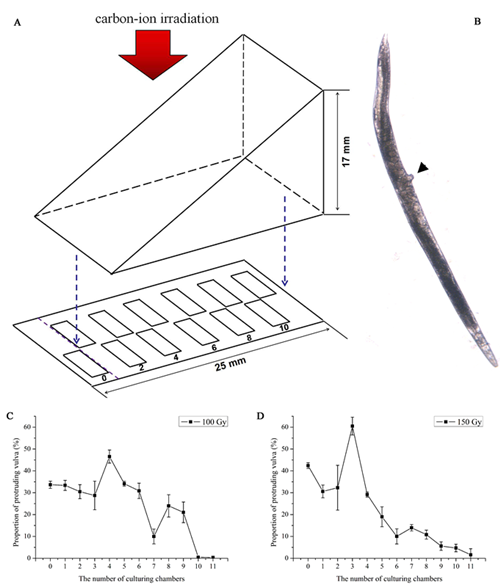
A study team led by Prof. BIAN Po in Institute of Technical Biology & Agriculture Engineering, Hefei Institutes of Physical Science made great progress in investigating the distribution of reproductive cell death (RCD) across the whole range of heavy-ion irradiation.
Heavy-ion radiation is well known for its high relative biological effectiveness. It attracts extensive attention as an effective cancer therapy because of the varying energy deposition along its track and its high cell-killing effect.
RCD, also known as clonogenic death, is an important mode of death of the cancer cells after radiotherapy. Although RCD induced by heavy-ion irradiation with various linear energy transfers has been demonstrated using clonogenic assay in vitro, little is known about the distribution of RCD across the range of heavy-ion irradiation at the level of whole organisms.
BIAN's team is the first to demonstrate the RCD distribution over the entire range using an in vivo model.
In their study, a polymethyl methacrylate wedge was used to provide gradually varying shielding thickness so as to position worms across the whole range of heavy-ion irradiation.
It was showed that the ratios of RCD in directly exposed worms and worms in the biological peak regions both increased with radiation doses.
Thus, cell death pattern might depend more on the radiation dose, also leading to an approximate position between biological and physical Bragg peaks.
The degree and shape of the range-distribution of RCD were also affected by the developmental stages of the worms. Mutant worms exhibited a reduced sensitivity to carbon-ion irradiation in the directly exposed culturing chamber, and similar radio-sensitivity in the biological peaks.
An increased induction of RCD was observed in the worms impaired in homologous recombination (HR), but not in non-homologous end jointing pathway, suggesting a crucial role of HR repair in vulval cells of C. elegans in dealing with the carbon-ion-induced DNA damage.
These unique manifestations of RCD in vivo in response to carbon-ion irradiation might provide new clues for further investigating the biological effects of heavy-ion irradiation.
This work was supported by the grants from National Natural Science Foundation of China, the Youth Innovation Promotion Association of Chinese Academy of Sciences.

Fig 1. The distribution of RCD across the range of carbon-ion irradiation. A) The schematic of carbon-ion irradiation setup; B) The phenotype of protruding vulva of C. elegans, as indicated by a black arrow head; C) 100 Gy; D)150 Gy. (Image by WANG Ting)

86-10-68597521 (day)
86-10-68597289 (night)

86-10-68511095 (day)
86-10-68512458 (night)

cas_en@cas.cn

52 Sanlihe Rd., Xicheng District,
Beijing, China (100864)

